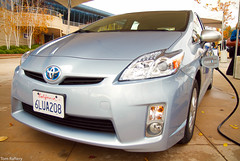| Chevrolet Volt at the Ride, Drive & Charge event organized by the EDTA, downtown Washington, D.C. (Photo credit: Wikipedia) |
A plug-in uses the internal combustion engine only as a back-up in case the electric motor runs out of battery power, regardless of the speed. And it uses electricity from the grid when it is charged.
Most plug-ins have a range of about 30+ miles before the battery runs out and the combustion engine kicks in. Some of the newer offerings will be able to go up to 70 or 80 miles before they require charging.
How Do They Work?
As noted above, a plug-in hybrid has two means of propelling it forward - an internal combustion engine (like a regular car) and an electric motor that runs on a battery. After each use, the car is plugged into a household current and charged. If you forget to plug it in or end up with a dying battery while on the road, the internal combustion engine will kick in. You can keep driving and the internal combustion engine will charge the battery. At this point, the plug-in hybrid is acting like a standard or full hybrid.
| Plug in hybrid from Toyota. (Photo credit: Tom Raftery) |
Plug-in hybrids are laid out like other hybrids in that they have a continuously variable transmission (CVT) that makes the transition from combustion engine to electric motor smooth. Plug-ins, like other hybrids, also shut off automatically at stop lights and start again when the driver takes his or her foot off the brake pedal. This reduces energy loss during idling. Overall, plug-in hybrids can be a great choice of alternative vehicle, and hopefully as demand increases and costs come down, limitations will improve and these cars will become widely available to the public.



There is a chance you're eligible for a new government solar rebate program.
ReplyDeleteDiscover if you're qualified now!